1943
January - February 1943
On January 1st, 1943, the Royal Canadian Air Force bomber squadrons of the 400 Block formed #6 RCAF Bomber Group. Among them was the French Canadian #425 Alouette Squadron. Canadian airmen conducted operations against submarine bases and bombed German cities and enemy war industries in night raids.
In 1944, tactical bombing will become the preferred method. Some RCAF aircraft patrolled sea traffic on the Canadian coastlines, while other airmen were sent overseas to train eight wings in the Coastal Command.
Their main task was to ensure the safety of Allied supply ships by attacking German U-boats. Nevertheless, U-boats managed to sink 2,900 ships transporting 14 million tons of goods in Atlantic waters.
![]()
March 1943
The RAF conducts a series of huge raids on German cities, especially Hamburg and Berlin, and industrial areas in the Ruhr
Essen was a regular target as part of the Battle of the Ruhr industrial sites bombing campaign.
On March 5th, 1943, 442 aircraft took part in the first raid of the Battle of the Ruhr that marked RAF Bomber Command's 100,000th sortie of the war!
About 3% of the force was lost and a further 56 aircraft had to fly back early. Three of these were Oboe-equipped Mosquito marker aircraft leaving only five to mark the target.
Marking was carried out 'blind', avoiding the effects of the industrial haze that usually concealed Essen. The Main Force bombed in 3 waves. 2/3rd of the bomb tonnage was incendiary, the rest high-explosive. 1/3rd of the high-explosive bombs were fused for long delay. The attack lasted 40 minutes.
Reconnaissance photographs showed 160 acres (0.65 km2) of destruction with buildings within the Krupp works hit by bombs. At least 461 civilians were killed, 1,593 injured and a further 50,000 became homeless.
In total between 1939 and 1945, the RAF will have dropped approximately 40,000 tons of bombs on Essen! 90% of the city center was destroyed.
The city will be taken by the 507th PIR of the 17th Airborne Division, on April 10th, 1945. They had taken part in the Airborne landing on D-Day in Normandy.
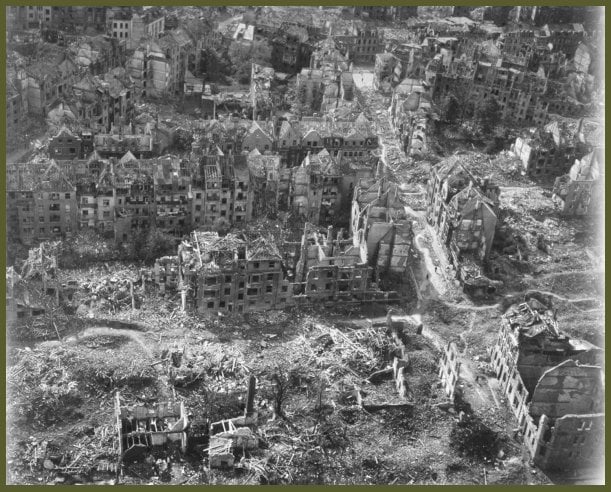
April - May 1943
The Atlantic struggle reaches a critical point in the Spring of 1943. After months of tragic losses, Allied forces start to drive out the U-boats and finally regain control of the seas.
Safeguarding the vital convoys upon which the Allies depend, U-boats are sunk daily. Even as battles at sea still continue, the focus of the Allied effort begins to shift.
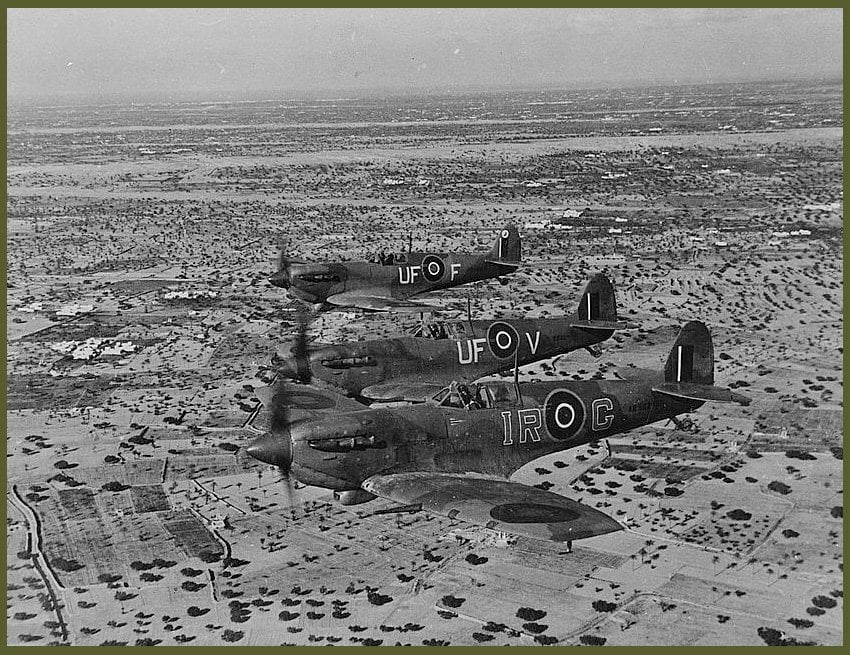
Operations in North Africa by Allied air forces. A formation of Spitfires on interception patrol over De Djerba Island, off Gabes, on their way to the Mareth Line area
June 1943
USAAF bombers attack German fighter productions sites. As of June 10th, 1943, to February 1944, the USAAF launched Operation Pointblank.
Operation Pointblank was officially issued on June 10th, 1943. The objective? To systematically bomb the German aircraft industry and infrastructure supporting the Luftwaffe.
German fighters have to be drawn into the defense of these vital targets and if possible, destroyed in combat.
It would take a few more months before the USAAF proved able to adequately defend deep bomber penetrations against intercepting Luftwaffe fighters. How so? By the development and fielding of long-range escort fighters such as the P-47 Thunderbolt.
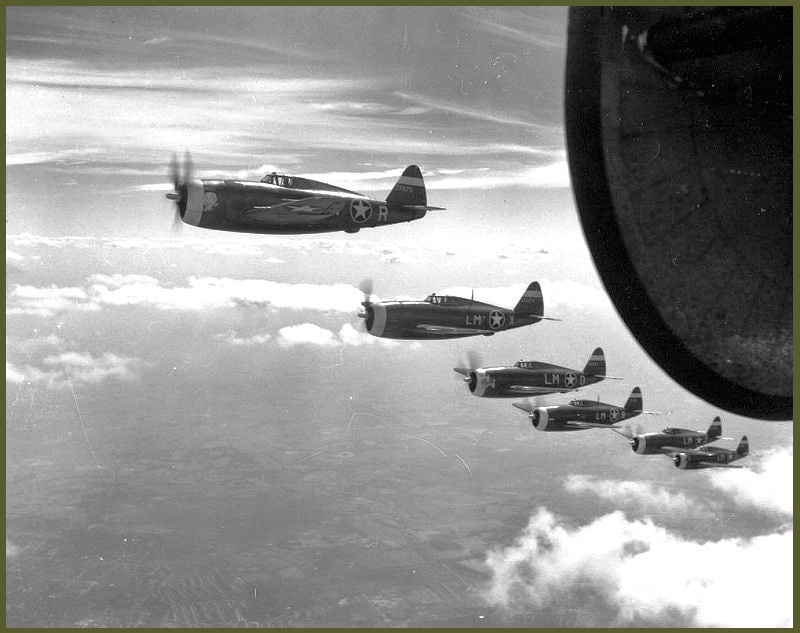
July 1943
July 24th to August 3rd, 1943 the Allies destroy Hamburg over 10 days of continuous bombing, code name Operation Gomorrah.
It created one of the largest firestorms raised by the USAAF and RAF, killing an estimated 58,000 civilians and wounding at least 180,000 in Hamburg, virtually destroying totally the city.
At least 25,000 tons of bombs were dropped during 69 raids of Hamburg!
Before the July raids, there had been no rain for some time and everything was very dry, creating during the bombing a vortex and whirling updraft of super-heated air which in turn created a high tornado of fire, 460 meters high!
Overall it incinerated more than 21 square kilometers (8 square mile) of the city!
The worst night will be July 27th, with the majority of deaths taking place during that raid.
A large number of the civilians seeking safety in bomb shelters and cellars will die, the firestorm consuming the oxygen in the burning city. The firestorm was so powerful that it could sweep people up off the streets like dry leaves.
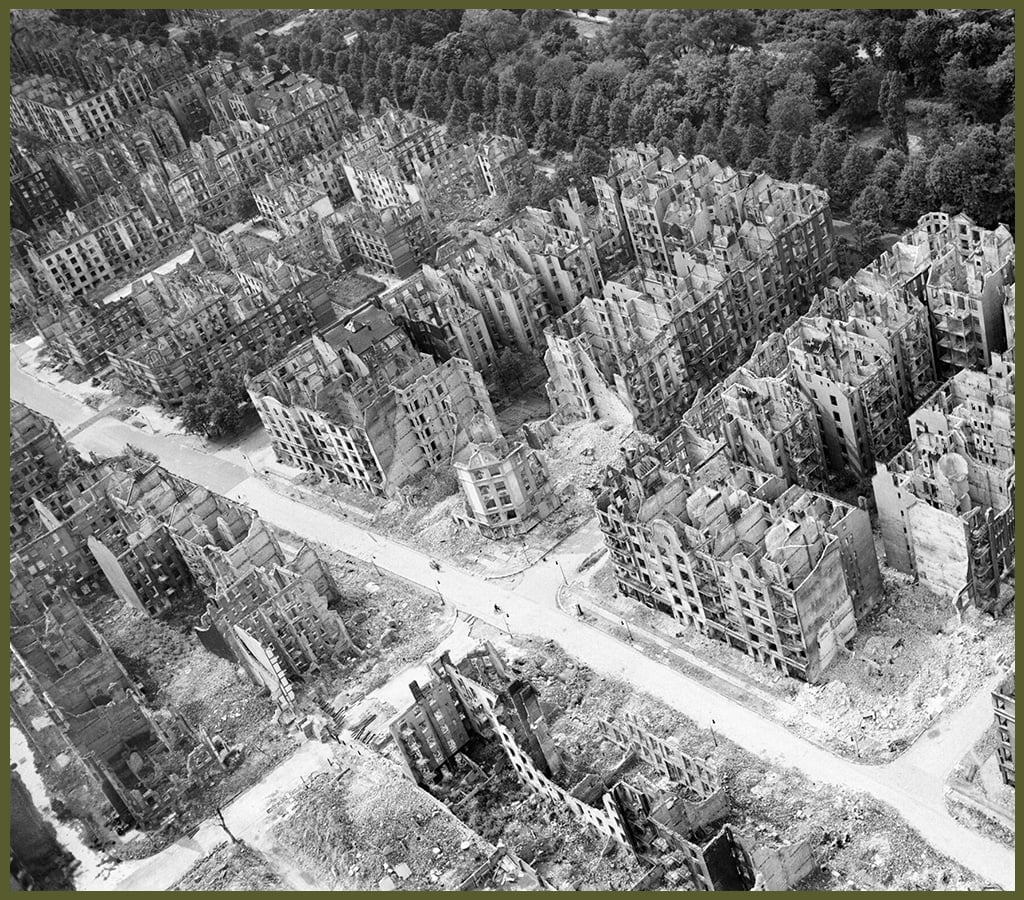
Major Cortez F. Enloe, a surgeon of the USAAF who worked on the United States Strategic Bombing Survey (USSBS) said in January 1946 that: “the fire effects of the atomic bomb dropped on Nagasaki were not nearly as bad as the effect of the RAF raids on Hamburg on July 27th, 1943”. He estimated that more than 40,000 people died that night in Hamburg!
The British officials will later call it the “Hiroshima of Germany”.
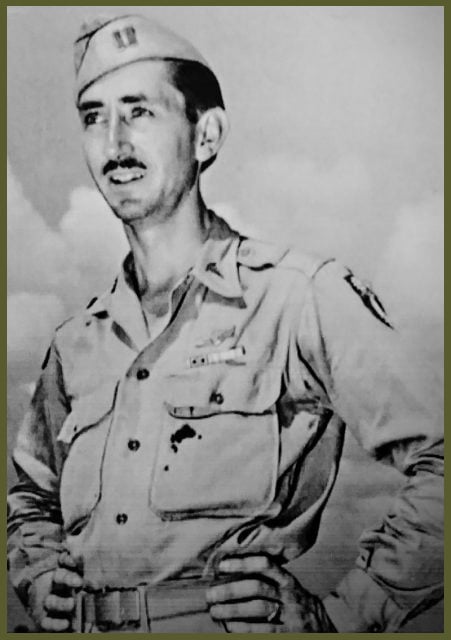
Major Cortez Enloe
August 1943
August 1st, 1943, USAAF bombers undertake a long-range attack against the oil fields of Ploesti, Romania. It’s one of the most famous American bombing raids of the war!
They made a daring low-level attack on oil fields which supplied a third of the Third Reich vital high-octane fuel. Only the Liberator had the range to reach these targets from airfields in North Africa.
As a heavy bomber operating in daylight, the B-24 needed to be capable of defending itself from attacks by enemy fighters. The nose, top, ball and tail turrets each had two 0.50-inch machine-guns and there were two more machine-guns in the waist.
It also needed a long, deep fuselage to house the crew stations and the extra-large bomb bay in the middle to carry a total of 3,992 kg (8,800 lbs.) bombs. The actual maximum bomb load including the external racks was 5,806 kg (12,800 lbs.).
Of the 178 aircraft sent, only 88 made it back to base. Of the 1,726 airmen involved, 500 were lost.
It was the first American heavy bomber to have a tricycle undercarriage, introduced to shorten take-off and landing runs. It was therefore easier to taxi and to land than similar tail-wheel types such as the B-17 with a range of 3,380 km (2,100 miles) with 2,268 kg (5,000 lbs.) bomb load.
44BG Mission Report – source 8th AFHS
Our 37 aircraft departed Benina at 0430(?) to attack their assigned targets of Credito-Minier and Columbia Aquila. 36 A/C reached targets between 1210 and 1213 hours at altitudes from 120 to 250 feet. 48 x 500 lb. GP bombs fused 45 second tail, and 139 x 1000 lb. bombs fused one-hour tail delay, plus 22 boxes of incendiaries dropped on targets along the route but taking no account of unreported planes.
The groups assembled as planned except for the 93rd, which due to blowing dust, were delayed in taking off with the result that they were unable to form over their field and had to do so enroute.
As the force reached the coast of Greece, the groups were in visual contact, but from the coast to the turning point of Pirot they encountered poor weather.
The 98th Group descended below the clouds, the other four remained above, and, in consequence, lost contact. The 376th and 93rd, separated from the other groups and turned for their run into the I.P. (Floresti) about 4 minutes too soon and, therefore, missed it. A run was made from a town which they mistook for Floresti, the mistake being undiscovered until the lead force (376th Group) sighted Bucharest. They then turned north toward the original IP, sighted Ploesti, and attacked the targets on a heading of 35 degree.
Only three ships from the 376th bombed an objective, the remainder salvoed their bombs in the fields. The 93rd sighted White III too late to change course and bombed White IV and White V. Their approach to the targets brought the two forces near the defenses on the outskirts of Bucharest, on through those of Brazi, and into the most intense in the Ploesti area, with a resulting high loss of aircraft.
Unfamiliar with the angle of approach, they were forced to climb to find their target and were subjected to fire from heavy anti-aircraft fire. The 389th and 44th Groups became separated from the 98th when the latter descended under the clouds on the way in from Greece to Pirot, and the 389th after coming to the conclusion that the others were uncertain of their own position, broke off and proceeded to Pitesti alone. Arriving in the foothills north of Pitesti, they became confused by the similarity of the valleys there and made a run down one of them towards Targovishte in the belief they were in the Prahova Valley. Discovering their mistake, they turned north again and made a second southerly run down the Prahova valley itself. This time they easily recognized and hit their target, the Steaua Romana Refinery. The hilly nature of the country surrounding the target apparently made a certain amount of surprise possible, as the first four waves over the target encountered little opposition, while the last wave met considerable resistance. No heavy anti-aircraft fire was reported.
The 44th BG, mistaking the 389th for the 98th BG, followed the former until their mistake was discovered. We then found ourselves ahead and above the 98th and so let down and circled behind into our proper position. They reached Pitesti and followed the planned route, by Floresti, to the target. White IV, already hit by the 93rd, was the target assigned to the 98th and their own certainty that they hit it well is upheld by their photos.
The comparatively small amount of damage shown in the P.R.U verticals leads to the belief that a great proportion of their bombs did not go off or were removed before they could do so, thereby tending to substantiate the information contained in the telegram from General Arnold, July 9th 1943 on experiments with 1000 lb. bombs with delayed fuses, in which it was found that 50% of the bombs failed to detonate when dropped against solid objectives from low level.
The 44th B.G. arrived at their Ploesti target at 15:15 hours, plunging into a hail of flak and ripping tracers, smoke, fire and exploding bombs. Several parts of the extensive plant were already afire, and to reach their specified target, the 44th would have to fly directly over this fiery and bursting cauldron of oil, and through a veritable forest of anti-aircraft guns. What had been modest barns and harmless appearing haystacks now became gun emplacements, and from everywhere, including handcars on the sidings, upward flew the barrage of steel. And from the flak towers, down came additional hail of metal.
Colonel Johnson headed for the target with the Group in perfect order behind, and here is where the real story of heroism and valor and sacrifice begins.
The Ploesti plant was a sprawling panorama of buildings stretched over several acres of land.
Because a concentrated attack on one specific target by the entire force employed would do but a minimum of damage, each group had been assigned a separate area on which to concentrate their strength. That had been the real purpose of a low-level attack.
The idea was to get in fast, drop the bombs and get out just as fast, but fate had ruled that it wouldn't be so, for as Colonel Johnson's Group approached their target, it was observed that through an error, another group has already bombed the target assigned to the 44th! What was there to do now? Fly straight on and turn for home, thereby nullifying months of preparedness, or seek an alternate target and possible doom?
In a split second, Colonel Johnson chose the latter. Altering his course and heading straight and low through the smoke and flames and floundering 24s, he made straight for a cracking plant as yet untouched. Planes were going down on all sides.
One, caught in the blast of an exploding bomb(s), pointed her nose upwards, climbing an imaginary ladder several hundred feet before falling onto its helpless back.
Another, completely enveloped in flames, plunged headlong into the flaming oil below, adding extra fuel to the raging fires, but Suzy-Q pressed onward to the new target with a flight of now crippled B-24s behind. Off Suzy's starboard wing six Liberators disappeared into a column of rising smoke, from which only one burnt and blackened pane emerged to follow the formation.
What now remained of the 44th continued to the target and deposited their bombs neatly and beautifully below. Now began the mad dash for home.
- Colonel Johnson's ship had ailerons and rudder perforated;
- Lieutenant Carpenter's bomb bay doors smashed and gas leaks in the starboard tanks; Lieutenant Mitchell, one engine feathered and one smoking;
- Captain Cameron's rudders and fuselage peppered;
- Lieutenant Henderson's with a thousand flak holes in all parts of the ship;
- Lieutenant Hill's right wing was severely cut between the fuselage and #3 engine all the way to the main spar where she had smashed through a balloon cable.
Such was the shape of the 67th ships leaving the target. Most were blackened by the oil fires, blistering the paint. Skimming low between and under telegraph wires and rubbing their bellies against fields of corn in order that they might avoid the fighters and flak towers, the big 24s dashed bravely along. Pursued by fighters and pounded from all directions, they nevertheless remained in their positions and finally broke into the clear.
- Lieutenant Mitchell was the first to leave the formation, heading in the general direction of Turkey;
- Lieutenant Henderson was next to leave and landed on the isle of Malta.
- Lieutenant Carpenter ditched in the Mediterranean 50 miles off the African coast, and all but two of the crew were rescued forty hours later.
- Lieutenant Fred Jones crash-landed in Italy;
- Lieutenant Worden Weaver and Lieutenant Reinhart went down over the target in flames.
All in all, five planes were definitely established as lost, while the remaining four would be out of action for some time. (67th planes only).
Loss of life was not as serious as at first feared and news came in that all damaged ships landed with but slight casualties to personnel. So, it came:
- Mitchell's crew in Turkey;
- Jones' prisoners in Italy;
- Henderson's in Malta;
- all but two rescued from Lieutenant Carpenter's.
Approximately 18 to 20 enemy aircraft attacked our formation with claims for 13 of them destroyed and 1 damaged. Only 23 of the 37 planes in our Group managed to land safely at the base, returning by 18:00 hours. 14 were unreported. One B-24 letter bar W, belly landed near the I.P. but the crew are believed safe. Other items include: Flak encountered at Verona on way out. Smoke screen at target started well in advance of arrival. 10 to 15 barrage balloons west of target flying at 4000 feet.
For Lieutenant Whitlock's crew (506th ) this mission was quite saddening as they were forced to abort some 125 miles short of the oil complex, near Craiova, Rumania. Fuel transfer problems and oiling difficulties caused the pilot to shut down #1 engine and feather the prop. We were tail-end Charlie, eating everyone's prop wash. We kept lagging farther behind until #4 engine lost power, too, so with no other choice, turned to return to base. Navigator Ricks gave a course heading to the nearest friendly landing field, Cyprus some five flying hours distance. Flying southbound they crossed the Danube at a point where people were wading and swimming, and not wanting to hurt them dumped their bombs farther down the river. They overflew Bulgaria into the Aegean Sea and skirted west of Turkey. 20 minutes from the Cyprus coast number four engine quit entirely. They were running out of altitude. At 500 feet and still dropping, Lieutenant Whitlock turned and asked S/Sgt. Chase if he was set up for a distress call - and he was. He knuckled out repeated SOS morse signals, giving code and holding the transmitter key down for 15 to 20 seconds so air-sea-rescue could home in on them. Meanwhile the crew threw out clothing, radio tuning units, ammunition, etc. to lighten the load so we could make landfall. The coast loomed in sight and luckily, they were lined up to land. No turning, straight in they went while S/Sgt. Chase fired red flares to ward off pattern aircraft. It was a good landing!
The 68th Squadron lost #42-40995 Co- Piloted by Captain Rowland B. Houston over the target. (A/C pulled up steeply)
The 66th lost 1st Lieutenant H.A. Lasco, Jr. in #42-24153 L "Sad Sack II" who went down after target.
Three 66th planes were caught in that terrific explosion:
- 1st Lieutenant G.W. Winger in #41-240l5 R "Wing Dinger";
- Captain R.M. Gentry in #42-40l82 A "Porky II"(?)
- 1st Lieutenant C.E. Hughes in #42-40777 N "Flossie Flirt".
Somehow, Lieutenant Hughes managed to take his shattered plane to Turkey. 1st Lieutenant T.E. Scrivner in #42-40375 G crashed near a clump of trees.
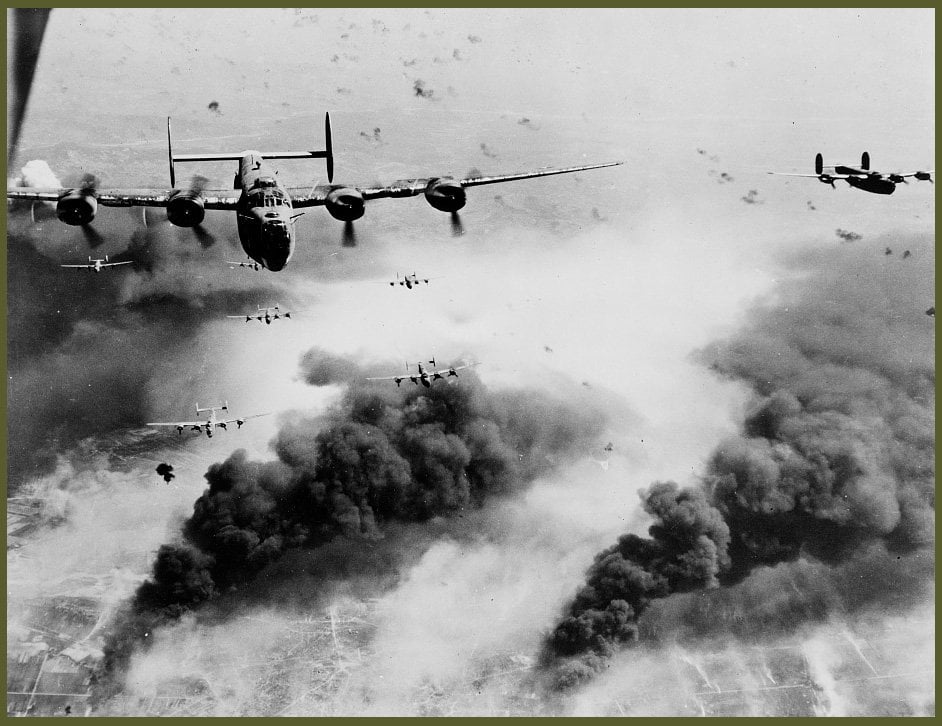
Waves of Consolidated B-24 liberators of the 15th USAAF fly over the targeted area, the Concordia Vega Oil refinery, Ploesti, Romania, unmindful of bursting flak, after dropping their bomb loads on the oil cracking plant, on May 31st, 1944
September 1943
The bombing of Ludwigshafen and Oppau were two of several strategic targets in the area, including additional targets of the Allies Oil Campaign of WWII.
The Allied Strategic Bombing effort targeted the refineries, synthetic fuel factories, storage deports and other petroleum-oil-lubrication production sites.
On September 3rd, 1943, 345 B-17s attacked the Ludwigshafen Oil refinery. This wasn’t the first time that the city was bombed! In May 1915, the first aerial mission of the French was a strategic bombing of the industrial site of Ludwigshafen with 18 bombers in reprisal to the poison gas attack led by the Germans in Ypres.
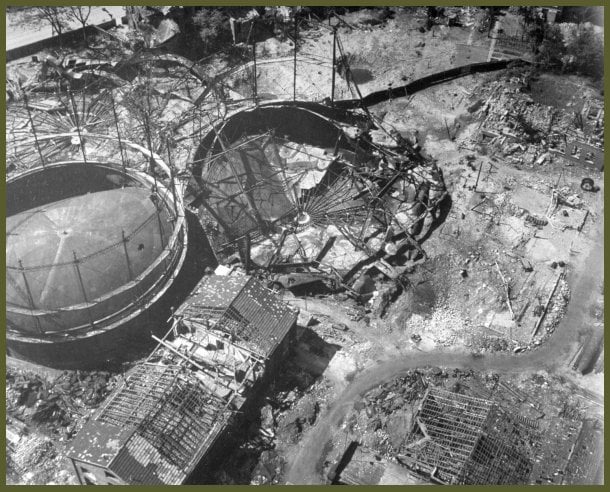
October 1943
American commanders had begun the war hoping that heavily armed B-17 and B-24 bombers would be able to defend themselves against fighter attack.
By October 1943, however, large numbers of these aircraft had been shot down by the German air force.
The bombers needed protection, but American fighters could not carry enough fuel to stay with them on their targets.
The USAAF solved this by fitting droppable fuel tanks to its fighters, and by introducing the P-51 Mustang, which could get to the furthest targets and still perform well in combat.
October 14th, 1943, USAAF bombers strike ball-bearing factories in Schweinfurt, in central German, and suffered huge losses.
Note: VIII Bomber Command Mission 115: 229 of 291 B-17s hit the city area and ball bearing plants at Schweinfurt, Germany in 2 group; the first group bombs at 1439-1445 hours, the second group at 1451-1457 hours; they claim 186-27-89 Luftwaffe aircraft; 60 B-17s are lost, 7 damaged beyond repair and 138 damaged; casualties are 5 KIA, 40 WIA and 594 MIA. The attack, which causes great damage and interference with production, results in German reorganization of the bearing industry. Fierce opposition of great numbers of fighters, many of them firing rockets, accounts for the 60 US aircraft shot down. As a result of these heavy losses, daylight bombing against strategic targets deep in Germany is discontinued for a short period. Only 29 of 60 B-24s are able to form up in poor weather; they abandoned their planned mission and fly a diversion towards Emden, Germany. Source 8th AFHS
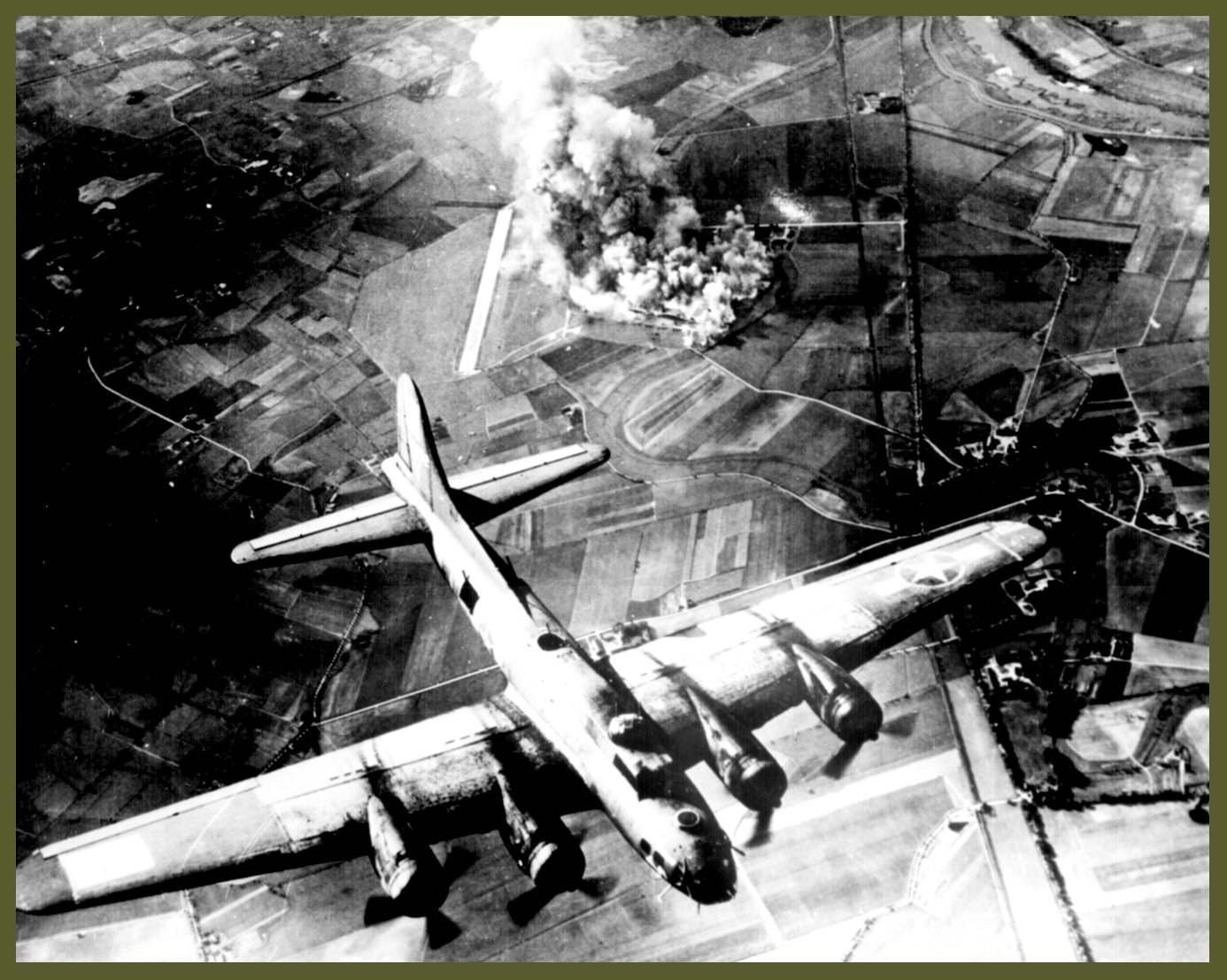
A US Eighth Air Force air raid on the "industrial area in Marienburg" on October 9th, 1943,
by 96 B-17 Flying Fortresses was called the Marienburg raid by Life magazine
November 1943
USAAF commanders begin to question their overall approach to daylight bombing. Meanwhile the Battle of Berlin, a series of attacks on Berlin by RAF Bomber Command (November 1943 – March 1944) caused immense loss of life and devastation in the capital.
On November 22nd, 1943, the raid killed at least 2,000 Berliners and rendered 175,000 homeless. It was the most effective raid on Berlin during the war. A total of 764 aircraft, of which 469 Lancasters were used with only a 3.5% loss during that raid.
The following night, 1,000 people were killed and 100,000 bombed out.
During December 1943 and January 1944, the Main Force raids killed hundreds of people and between 20,000 and 80,000 became homeless each night
As for the RAF, it lost more than 7,000 aircrew and 1,047 bombers, 5% of the sorties flown.
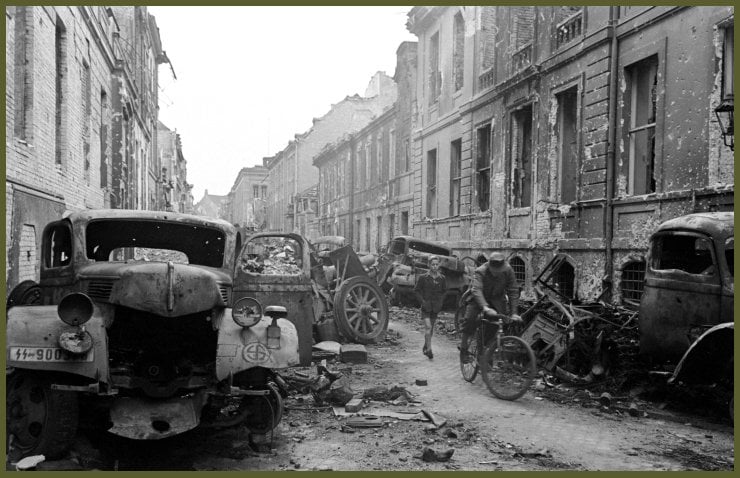
The Ninth Air Force
It was created to go with the Allies armies as they fought their way across Europe to Germany.
In Egypt during January 1943, IX Fighter Command became the control organization for Ninth Air Force fighter units assigned to the Western Desert Campaign (Libya and Tunisia) and was reassigned to England in November 1943 as part of Normandy invasion planning.
The Ninth Air Force’s aircraft and crews transported troops and provided photographs of enemy positions. They also worked closely with the ground troops and attacked targets on or near the frontline.
P-47 Thunderbolts were used in a “fighter bomber” role to knock out enemy tanks, bomb and strafe thickets hiding enemy troops and generally clearing the roads ahead of the advance. The B-26 Martin Marauder will also be used to attack convoys, destroy bridges etc.
Facilities at the Ninth’s temporary airfields in the U.K. were very basic! Despite these conditions, the Ninth Air Force played an important part in the upcoming victory in Europe.
“The Jerries are frightened to death of fighter-bombers” said a soldier. “The effect is just the opposite on our troops. You ought to see those guys in the frontlines stand there and grin and cheer when our pilots fly over to give them support”, said another soldier.
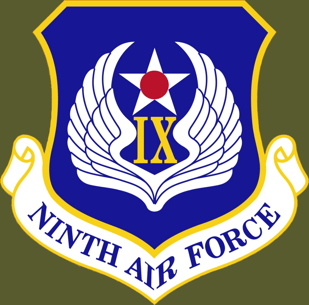
December 1943
USAAF fighter aircraft finally begin to escort the bombers all the way to their targets!
More than 1.5 million American soldiers, sailors, airmen and marines are pouring into the British Isles, in preparation for the largest amphibious assault in history. New friendships emerge, as fifteen different cultures are thrust together in the great undertaking, what will be known as “The Great Crusade”
A team is built through months of preparation, training is grueling at the Assault Training Center and at times lethal on Slapton and Blackpool Sands.
Note: 120 of 125 B-17s hit the industrial areas at Paris-Ivry and Bois-Colombes at 1207-1227 hours; 1 B-17 is lost, 1 damaged beyond repair and 49 damaged; casualties are 2 WIA and 10 MIA. These missions are escorted by 74 P-38s, 441 P-47s and 33 Ninth Air Force P-51s; they claim 9-1-1 Luftwaffe aircraft; 1 P-38, 2 P-47s are 1 P-51 are lost; 1 P-38 and 6 P-47s are damaged beyond repair and 1 P-38 is damaged; casualties are 3 WIA and 2 MIA. Source 8th AFHS
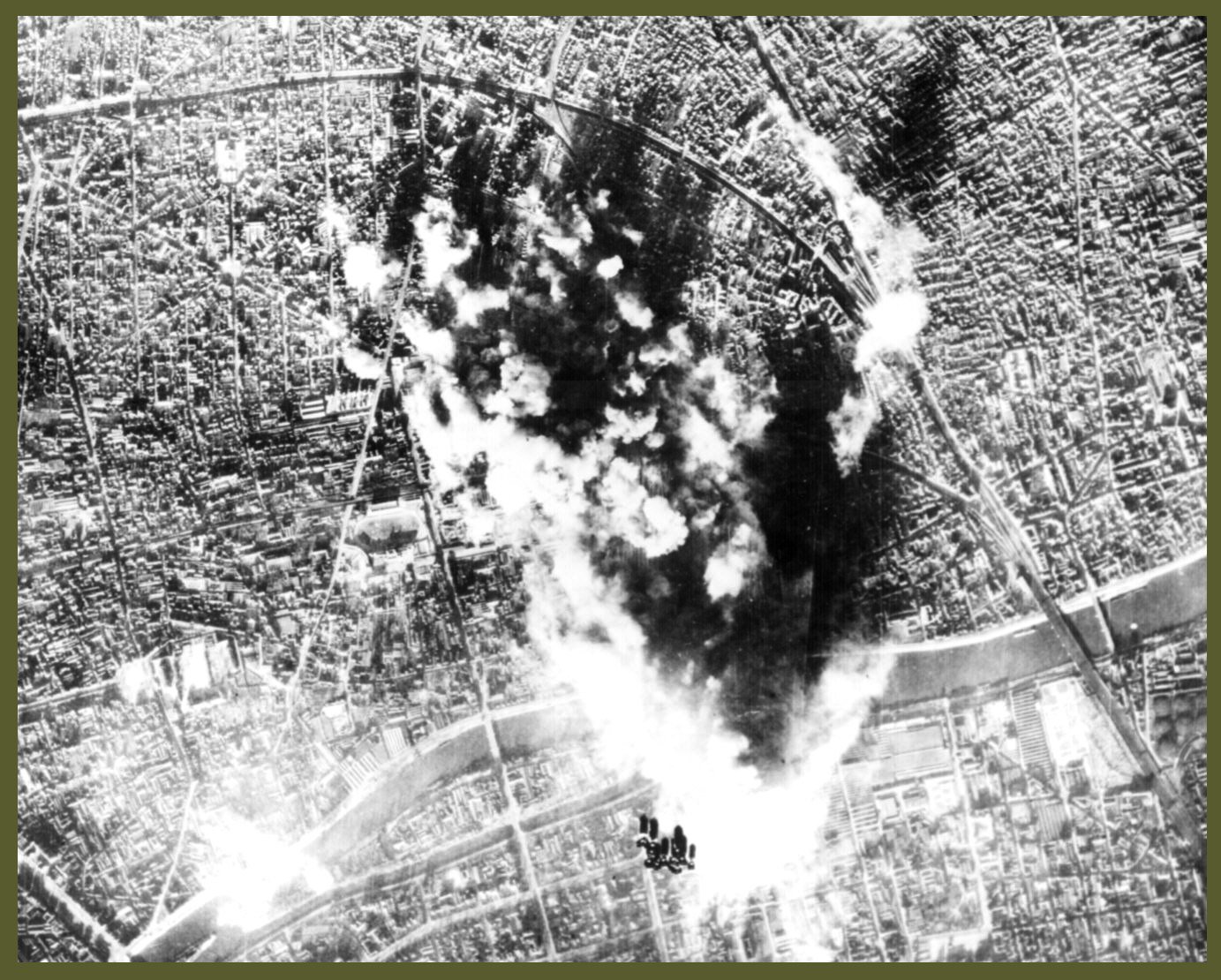
B-17 Flying Fortress of the 8th USAAF Bomber Command on December 31st, 1943
attacking the vital CAM ball- bearing plant Paris, France
Approximately 200,000 tons will be dropped between January and December 1943, 5 times more than in 1942!

















